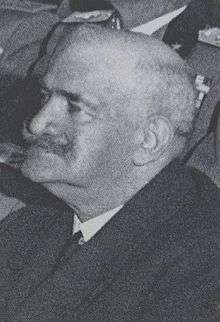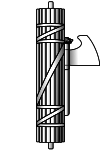Costanzo Ciano
| Costanzo Ciano | |
|---|---|
 | |
| President of the Italian Chamber of Deputies | |
|
In office 28 April 1934 – 2 March 1939 | |
| Preceded by | Giovanni Giuriati |
| Succeeded by | Himself as President of Chamber of Fasci and Corporations |
| President of Chamber of Fasci and Corporations | |
|
In office 23 March 1939 – 26 June 1939 | |
| Preceded by | Himself as President of the Italian Chamber of Deputies |
| Succeeded by | Dino Grandi |
| Personal details | |
| Born |
30 August 1876 Livorno, Italy |
| Died |
26 June 1939 (aged 62) Lucca, Italy |
| Nationality | Italian |
| Political party | National Fascist Party |
| Children | Galeazzo Ciano |
| Profession | Naval commander |
Costanzo Ciano, 1st Count of Cortellazzo and Buccari (30 August 1876 – 26 June 1939) was an Italian naval officer and politician. He was the father of Galeazzo Ciano.
Biography
Early life
Born at Livorno the son of Raimondo Ciano and wife Argia Puppo, he entered the Naval Academy of Livorno in 1891, being commissioned an officer five years later. In 1901, he became Tenente di vascello and took part in the Italo-Turkish War of 1911–1912.
The First World War
In 1915, at the entrance of Italy in World War I, he was a Capitano di corvetta (lieutenant commander), and was assigned to service in Cirenaica. After his return to Italy, he operated at the command of fast MAS units, receiving a Gold Medal for Military Value for a famous action in Bakar Harbour in Istria, which was later celebrated by the poet Gabriele D'Annunzio (who had also participated). Ciano was appointed Senior commander at the end of the war and ennobled by King Victor Emmanuel III as Conte di Cortellazzo e Buccari.
Post-war fascist
Ciano's ardent nationalism drew him into fascism. He became leader of the Livorno fascio and participated in the March on Rome in October 1922.[1]
On 31 October 1919, he assumed the post of Undersecretary of State for the Regia Marina and Commissioner for the Merchant Navy. On 9 November 1923, he was appointed rear admiral in the Naval Reserve. He was President of the Italian Chamber of Deputies from 1934 until his death, which occurred at Ponte a Moriano in 1939.
References
- ↑ Paul H. Lewis (2002). Latin fascist elites: the Mussolini, Franco, and Salazar regimes. Greenwood Publishing Group. pp. 30–31, 184. ISBN 0-275-97880-X. Retrieved 2009-06-04.
External links
- Newspaper clippings about Costanzo Ciano in the 20th Century Press Archives of the German National Library of Economics (ZBW)
| Political offices | ||
|---|---|---|
| Preceded by Giovanni Giuriati |
President of the Italian Chamber of Deputies 1934–1939 |
Succeeded by Dino Grandi |
| Italian nobility | ||
| Preceded by New creation |
Count of Cortellazzo and Buccari 1925–1939 |
Succeeded by Galeazzo Ciano |
